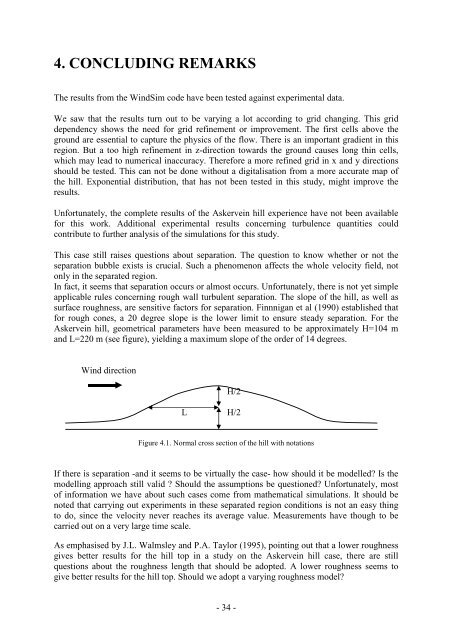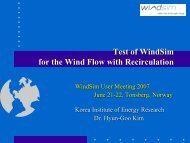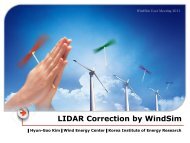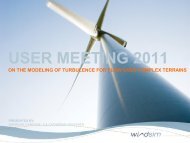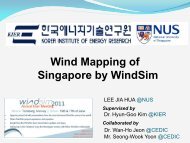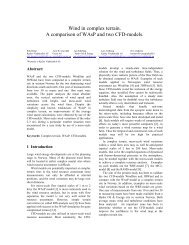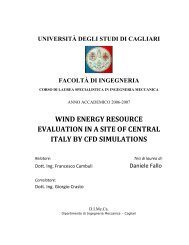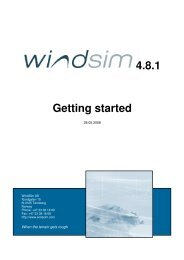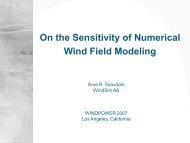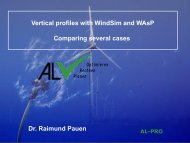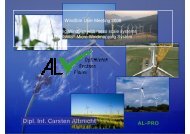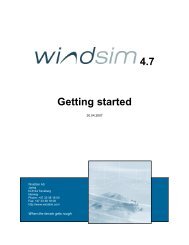Wind field simulations at Askervein hill - WindSim
Wind field simulations at Askervein hill - WindSim
Wind field simulations at Askervein hill - WindSim
You also want an ePaper? Increase the reach of your titles
YUMPU automatically turns print PDFs into web optimized ePapers that Google loves.
4. CONCLUDING REMARKS<br />
The results from the <strong>Wind</strong>Sim code have been tested against experimental d<strong>at</strong>a.<br />
We saw th<strong>at</strong> the results turn out to be varying a lot according to grid changing. This grid<br />
dependency shows the need for grid refinement or improvement. The first cells above the<br />
ground are essential to capture the physics of the flow. There is an important gradient in this<br />
region. But a too high refinement in z-direction towards the ground causes long thin cells,<br />
which may lead to numerical inaccuracy. Therefore a more refined grid in x and y directions<br />
should be tested. This can not be done without a digitalis<strong>at</strong>ion from a more accur<strong>at</strong>e map of<br />
the <strong>hill</strong>. Exponential distribution, th<strong>at</strong> has not been tested in this study, might improve the<br />
results.<br />
Unfortun<strong>at</strong>ely, the complete results of the <strong>Askervein</strong> <strong>hill</strong> experience have not been available<br />
for this work. Additional experimental results concerning turbulence quantities could<br />
contribute to further analysis of the <strong>simul<strong>at</strong>ions</strong> for this study.<br />
This case still raises questions about separ<strong>at</strong>ion. The question to know whether or not the<br />
separ<strong>at</strong>ion bubble exists is crucial. Such a phenomenon affects the whole velocity <strong>field</strong>, not<br />
only in the separ<strong>at</strong>ed region.<br />
In fact, it seems th<strong>at</strong> separ<strong>at</strong>ion occurs or almost occurs. Unfortun<strong>at</strong>ely, there is not yet simple<br />
applicable rules concerning rough wall turbulent separ<strong>at</strong>ion. The slope of the <strong>hill</strong>, as well as<br />
surface roughness, are sensitive factors for separ<strong>at</strong>ion. Finnnigan et al (1990) established th<strong>at</strong><br />
for rough cones, a 20 degree slope is the lower limit to ensure steady separ<strong>at</strong>ion. For the<br />
<strong>Askervein</strong> <strong>hill</strong>, geometrical parameters have been measured to be approxim<strong>at</strong>ely H=104 m<br />
and L=220 m (see figure), yielding a maximum slope of the order of 14 degrees.<br />
<strong>Wind</strong> direction<br />
H/2<br />
L H/2<br />
Figure 4.1. Normal cross section of the <strong>hill</strong> with not<strong>at</strong>ions<br />
If there is separ<strong>at</strong>ion -and it seems to be virtually the case- how should it be modelled? Is the<br />
modelling approach still valid ? Should the assumptions be questioned? Unfortun<strong>at</strong>ely, most<br />
of inform<strong>at</strong>ion we have about such cases come from m<strong>at</strong>hem<strong>at</strong>ical <strong>simul<strong>at</strong>ions</strong>. It should be<br />
noted th<strong>at</strong> carrying out experiments in these separ<strong>at</strong>ed region conditions is not an easy thing<br />
to do, since the velocity never reaches its average value. Measurements have though to be<br />
carried out on a very large time scale.<br />
As emphasised by J.L. Walmsley and P.A. Taylor (1995), pointing out th<strong>at</strong> a lower roughness<br />
gives better results for the <strong>hill</strong> top in a study on the <strong>Askervein</strong> <strong>hill</strong> case, there are still<br />
questions about the roughness length th<strong>at</strong> should be adopted. A lower roughness seems to<br />
give better results for the <strong>hill</strong> top. Should we adopt a varying roughness model?<br />
- 34 -


